Promise rings symbolize love. Worn on any finger, a promise ring represents a couple’s commitment to their relationship. Learn more about promise ring meaning, its history and how to give one. (more…)
Promise rings symbolize love. Worn on any finger, a promise ring represents a couple’s commitment to their relationship. Learn more about promise ring meaning, its history and how to give one. (more…)
If you’re shopping for a diamond engagement ring and see the price tag, you may wonder, are diamonds rare? Why do they cost so much? Is demand only driven by advertising? Do they have intrinsic value? We look at these questions and more.
(more…)
The three stone engagement ring is a classic style, and now that the Duchess of Sussex, Meghan Markle, is wearing one, it’s a popular choice. What does it symbolize? Which diamond shapes work best? Follow these tips to pick a beautiful one.
In this blog, we cover:
What’s the meaning of a three stone engagement ring?
What has more sparkle: a diamond solitaire or a three stone engagement ring?
Which diamond shapes work best for a three stone engagement ring?
Diamonds are popular side stones in a three stone engagement ring
Colored stones can be side stones in a three stone engagement ring
What mountings work best for a three stone engagement ring?
A three stone engagement ring typically has one center diamond bordered on each side by another gem of the same size or smaller. The three stone engagement ring style dates back at least to the 17th century, and it is rich in meaning. To some, the three stones represent a love that encompasses “yesterday, today and tomorrow.” To others, they symbolize “friendship, love and fidelity” or “mother, father and child.” Others believe the three stone engagement ring represents the Holy Trinity. In some designs, the center stone is a colored gem, but here we will focus on three stone engagement rings with a diamond at the center.

A treasure from the Victorian era (1837-1901), this three stone engagement ring is set with old mine cut diamonds in 18K gold. Courtesy: DoyleDoyle.com
Cut, one of the 4Cs of diamond quality (the other three are Color, Clarity and Carat Weight), is an important factor in how much a diamond sparkles – diamond experts call that ‘scintillation.’ The GIA cut grade takes into account the diamond’s proportions, culet size and girdle thickness, as well as the symmetry of its facet arrangement and the quality of the polish on those facets. Facets are like tiny mirrors. Their size and placement will influence how light behaves as it passes through the diamond and back to your eye.

A diamond solitaire in a six-prong setting is a classic engagement ring. Courtesy: JK & Co. Jewelers
GIA only grades the cut of round brilliant diamonds; other diamond shapes do not receive cut grades. A round brilliant’s potential cut grade ranges from Excellent to Poor. You can take a deep dive into understanding diamond cut by reading GIA Diamond Cut Grade: Six Things You Need to Know. A GIA Diamond Grading Report can tell you a round brilliant’s cut grade, giving you objective information you need to make a comparison. Learn more about comparing loose diamonds by reading our blog.
Assuming in both cases the diamonds are of equal size and quality, a three-stone diamond engagement ring will have more sparkle than a diamond solitaire. But what if you’re comparing diamonds with different cut grades? Or you’re comparing diamonds that are not round brilliants? Or for the same price as the three stones you can get a solitaire that is significantly larger? If sparkle is what you’re looking for when comparing diamonds of different shapes, cut grades or sizes, view the solitaire and the three stone rings under different lighting environments – and not just under the bright lights of the store.

A trio of oval diamonds creates a mesmerizing piece. The center diamond weighs 1.70 carat (ct) and the two side stones total 0.78 carats. Courtesy: EraGem.com
Since the round brilliant is the most popular diamond shape, it’s no surprise that you’ll see many three stone engagement rings set with round brilliants. Other popular diamond shapes for three stone engagement rings are the oval and the square or rectangular princess cut and cushion cut. An engagement ring with one large and two smaller emerald cuts has a sleek, sophisticated look. The symmetry of this shape brings a grace and rhythm to the ring.
You can also mix and match shapes. For example, a trilliant cut diamond on either side of a marquise, oval or princess cut diamond would frame the center stone nicely.

Mixing diamonds of different shapes and colors can create an unforgettable piece. This ring has a 3.03 ct fancy yellow cushion cut diamond bookended by 0.54 carats of half-moon cut diamonds. Platinum, yellow gold and rose gold are artfully used to create more visual richness. Courtesy: Novel Collection
Many three stone engagement rings feature a prominent center diamond flanked by two smaller side stones. To create a harmonious look, jewelry designers and manufacturers often pick side stones that have color grades identical or close to the grade of the center diamond. GIA organizes diamond color into five groups:
You can use this information when searching for side stones to complete your three stone engagement ring. Diamond Color: Seven Things You Need to Know gets to the heart of diamond color.
Clarity grades should also be similar but need not be identical, as most inclusions are not visible with the unaided eye unless the diamond has a grade of Included (I1, I2 or I3). Learn more in Seven Things You Need to Know About Diamond Clarity and VVS versus VS Diamond: What’s the Difference in Diamond Clarity?
Want to add a pop of color to your three stone engagement ring? Then consider adding rubies or sapphires as side stones. Both gems are cherished for their beauty. They are also a 9 on the Mohs scale of hardness, making them durable, long-lasting choices for an engagement ring (only a diamond is harder). You can use colored gems as the center stone of your ring. Here are tips for picking a stunning ruby or sapphire. You also have other choices for colored gemstones, and we share them in our Buying Guide: Colored Gemstone Engagement Rings.

A 1.39 ct round brilliant cut diamond is framed by two round rubies weighing 1.41 ct and 1.37 ct. Courtesy: 1stdibs.com

Two sapphires are a tranquil evening sky against which the center diamond glitters like a bright star. Courtesy: Omi Privé
Deciding how to set the stones in a three stone engagement ring is a matter of personal preference and your beloved’s lifestyle. The most common choices are prong and bezel settings.
A prong is a narrow metal support, usually in groups of four to six, used to hold a gemstone securely in place. A bezel is a thin metal strip that is pushed or hammered around the edges of a gem to hold it in place. Prongs will show off the diamond better, as the least amount of metal will be on the stone. Less metal means more diamond to see and admire. The trade-off is that diamonds in a prong setting can be more vulnerable to damage than those in a bezel setting. Because a bezel setting protects the stone, it is an excellent choice for individuals who are physically active and love the outdoors.

In this engagement ring, prongs hold the three diamonds in place. Courtesy: 1stdibs.com
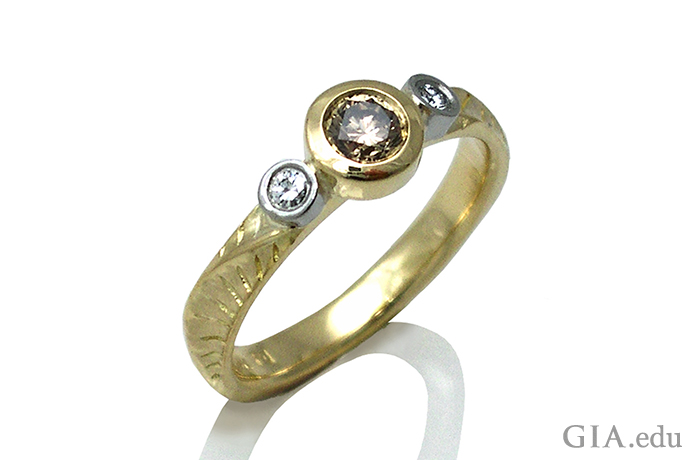
Play ball! Or go hiking, rock climbing or whatever your favorite sport. The center 0.25 ct brown diamond and 0.07 carats of colorless side diamonds are secure in their bezel settings. Courtesy: K. Mita Design
The three stone engagement ring has charmed for centuries – and is now especially chic. Pick a beautiful one, and you’ll have an engagement ring that is timeless.
The three stone engagement ring is hot, and so are these seven other irresistible Engagement Ring Styles.
“Will you marry me?” It’s the ultimate question. You want the marriage proposal to be perfect and the answer to be “yes!” There’s a lot that goes into popping the question. But have no fear. Follow these common tips for how to propose in a few simple steps. (more…)
A cruise ship vacation offers a sea of buying options for diamond or colored gemstone jewelry. To get the best value for your memento, it pays to do some homework and know the risks of buying jewelry while on a cruise. (more…)
Many jewelers offer a way to create your own engagement ring featuring the use of semi mount rings. These partially set mountings let you create an engagement ring that is uniquely yours, often more quickly and for less money than a custom engagement ring. (more…)
Ready to propose but not ready to buy an engagement ring? A placeholder ring is a great stand-in while you work out the thousand-and-one details that go into buying your forever engagement ring. Here’s what to consider: (more…)
Men’s wedding rings don’t have to be plain. Make a statement by adding diamonds or other gems to metals like stainless steel, platinum or different gold colors. We’ll help you and your groom pick one that’s both stylish and practical.
Diamond stud earrings can dress up your look. They add a splash of style to any outfit. And turn heads. Just ask trendsetter Meghan Markle, now the Duchess of Sussex. Here’s how to choose a pair of diamond studs you’ll love. (more…)
If you’re shopping for an engagement ring, you need to know about carat weight – the measurement of how much a diamond weighs. Carat weight is important because it helps determine a diamond’s price and reflects its rarity. We take a closer look. (more…)
Gold engagement rings are forever favorites. But how do you pick the right color gold for your ring style and center diamond? Here’s a quick breakdown on gold alloys and what to consider when making this important engagement ring decision. (more…)
Colored gemstone engagement rings are hot. They’re showing up on royalty and celebrities alike. They’re beautiful. They’re unusual. And they can be a great value. Here’s what you need to know when you go shopping.
In this blog, we cover:
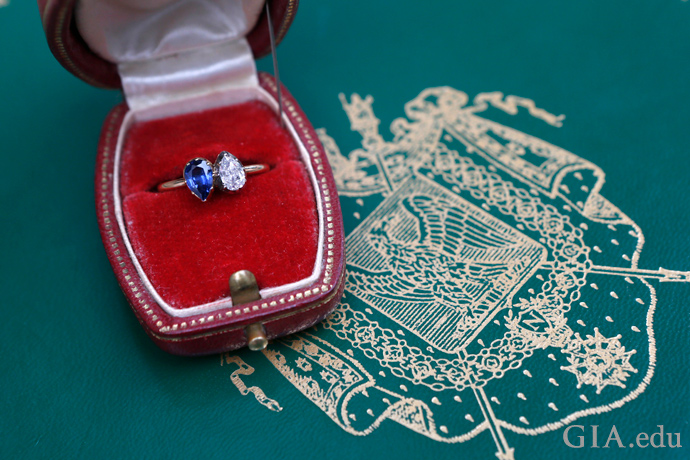
The Empress Josephine toi et moi (“you and me”) engagement ring features a 1 carat (ct) pear shaped sapphire and diamond mounted in 18K gold. Photo: PATRICK KOVARIK. Courtesy: AFP/Getty Images
Colorful gemstone engagement rings are decorating the fingers of royals and other style makers, reviving a not-so-new trend for adding pops of color – and personality – to traditional colorless diamond engagement rings.
Some stylistas are achieving the color-me look with pink, yellow or blue diamonds, while others turn to the world of colored gemstones to find their splash of color.
More than 200 years ago, in 1796, Napoleon Bonaparte gave his future empress, Joséphine, a sapphire and diamond toi et moi (“you and me”) ring for their engagement.
Today, Kate Middleton, the Duchess of Cambridge, wears what is probably the most famous colored gemstone engagement ring. A beautiful creation that once belonged to Princess Diana, it boasts a 12 ct sapphire encircled by diamonds.
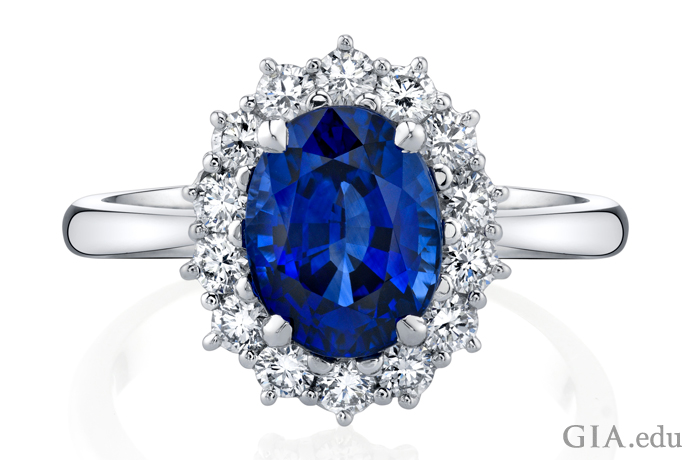
If you like Kate Middleton’s engagement ring, then you’re sure to love this beauty. A 2.73 ct oval sapphire glows the brighter for being accented by 0.56 carats of diamonds. Courtesy: Omi Privé
Kate’s recently engaged cousin by marriage, Princess Eugenie, daughter of Prince Andrew and Sarah Ferguson, opted for a slightly orangy pink padparadscha sapphire, surrounded by round brilliant cut diamonds. The style somewhat resembles the engagement ring her mother (the Duchess of York) received – a ruby with a halo of diamonds.
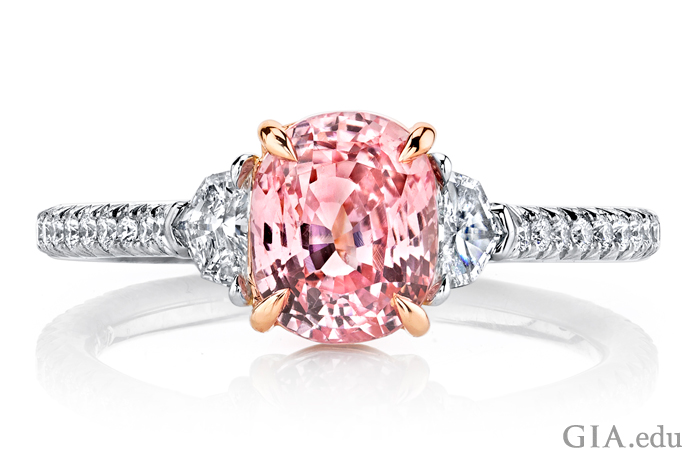
Like Princess Eugenie’s engagement ring, this 2.02 ct padparadscha sapphire and diamond ring is both beautiful and unusual. Courtesy: Omi Privé
In the celebrity world, actress Jenny McCarthy wears a 10 ct yellow sapphire engagement ring framed by diamonds. Ashlee Simpson’s vintage-style ring features a marquise diamond surrounded by calibré cut rubies. Elizabeth Hurley sports a 9 ct blue sapphire framed by two trilliant cut diamonds in a classic design.
For these trendsetters – and many other brides – incorporating colored gemstones into an engagement ring offers myriad options to display their individual style and personality. It’s a look that’s both timeless and contemporary.
There’s a lot to love about colored gemstone engagement rings. First, there’s the obvious: color. Explore the world of colored gems and you’ll find a rainbow, from the deep reds of ruby and blues of sapphire, to the grassy greens of tsavorite garnet and kaleidoscopic colors of spinel. There’s a gem for every hue imaginable.
Second, with colored gemstones you can add more depth of meaning to the engagement ring. For example, you could include your birthstone and your partner’s birthstone, alone or with diamonds. Colored gemstones also come with historic symbolism, and you could pick one that inspires you. Take sapphire – it has traditionally been associated with sincerity, truth and faithfulness.
You can also use colored gemstones to send secret messages. The Victorians turned this into an art form with acrostic jewelry – using the first letter of each gemstone to spell a word. For example, a diamond, emerald, amethyst and ruby set together would spell the word “dear.” Acrostic jewelry can also be designed to spell birthdays, private messages or a secret shared between you and your beloved.
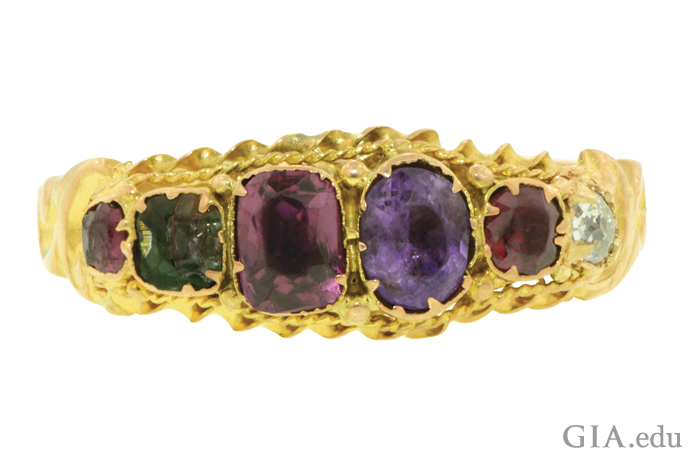
This acrostic ring was made in England during the Victorian era (1837–1901). The gems spell “regard” from left to right: ruby, emerald, garnet, amethyst, ruby and diamond. Courtesy: Doyle & Doyle
Finally, there’s affordability. Colored gemstones are a great way to add size to an engagement ring. This is especially true if you look beyond rubies and sapphires toward gems that are less well known but equally as beautiful – and usually significantly less expensive. Examples include the pink beryl morganite, the many colors of spinel and tourmaline, or intense green, red or orange garnets.
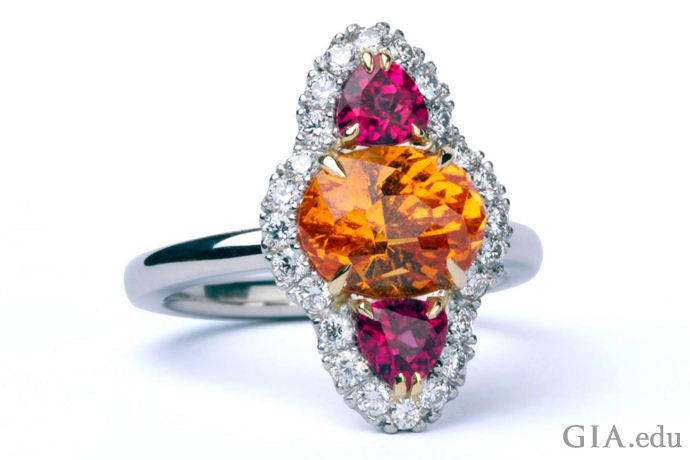
If your bride-to-be’s favorite colors are orange and pink, this ring featuring a spessartine garnet center stone cut by John Dyer, pink tourmaline side stones and diamond melee is sure to please. Courtesy: John Dyer & Co.

The color of morganite can be very similar to that of a pink diamond, but this 7.07 ct morganite is a striking – and more affordable – option. Courtesy: 1stdibs.com
Morganite engagement rings are recent favorites with brides-to-be – and for good reason. Pink has traditionally been the color of romance, and morganite ranges from pastel pink to purplish, yellowish or orangy pink. Similar hues are seen in pink diamonds, but you can have a large, attractive morganite for a small fraction of their cost.
Blue zircon, with its high dispersion, is often mistaken for blue diamonds. Yet while the cost of even a 1 ct blue diamond would be prohibitive for most buyers, a 3 or 4 ct blue zircon engagement ring is obtainable for far less than an average month’s salary.
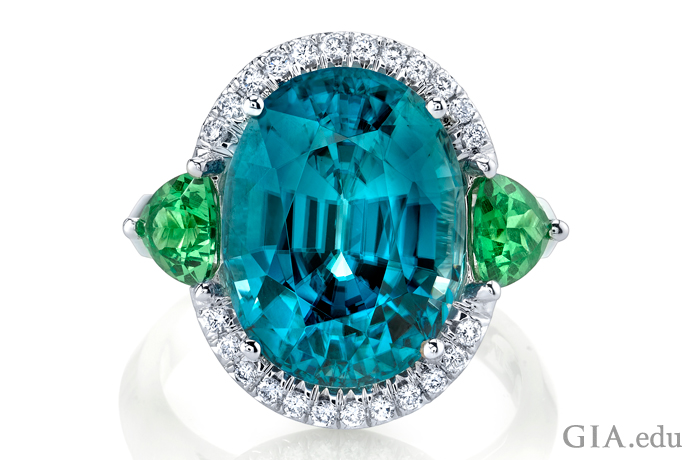
Find beauty in blue with this 6.74 ct cushion cut zircon ring accented with trilliant cut tsavorite garnet side stones and round brilliant cut diamonds set in 18K white gold. Courtesy: Omi Privé
Spinel and tourmaline are two other gems that offer a wide range of color options and great value. They occur in colors that are very similar to those of fine ruby or sapphire, but a top-quality 5 ct red tourmaline (rubellite) could be purchased for less than a third of the cost of a comparable 2 ct ruby – delivering more bling for your buck.
One of the most exciting, if less well known, colored gemstones seen in engagement rings is the green garnet known as tsavorite. More durable and often brighter than emerald, whose color it mimics, a fine tsavorite garnet is usually less expensive than its counterpart.

An alternative and more durable option than emerald, this 2.86 ct tsavorite ring with diamond accents stands out from the crowd. Photo: Emily Lane/GIA. Courtesy: Sara and Bret Keller
With so many different colored gemstones available, your challenge will be finding one that sets your heart aflame – and making sure the gem is tough enough for daily wear.
Durability is a major consideration when searching for an engagement ring gemstone. The gem you choose must withstand the bumps and bangs of daily wear, plus the effects of heat, light, household chemicals and low or high humidity. Different gemstones have different properties and, as a result, different tolerances to these stressors.
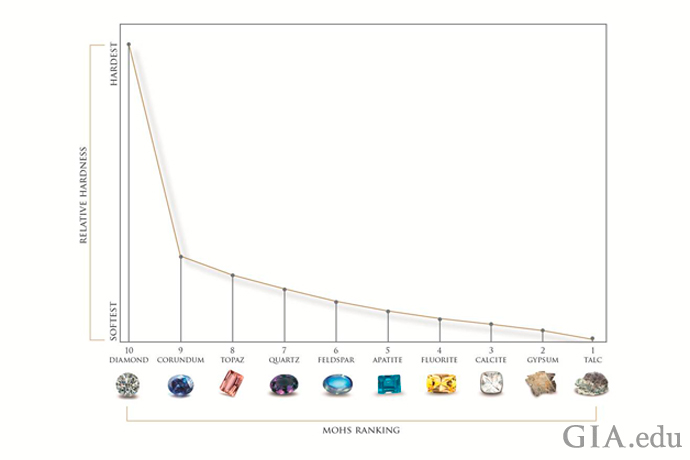
Introduced in the early 19th century, the Mohs scale ranks gem and mineral hardness in a range from 1 (least hard – talc) to 10 (hardest of all – diamond). Illustration: GIA
One aspect of gemstone durability is hardness. The Mohs scale ranks gem and mineral hardness on a scale of 1 (least hard – talc) to 10 (hardest of all – diamond). Ruby and sapphire rank 9, meaning they are able to resist scratching and abrasions. This makes them great choices for engagement rings that will see a lifetime of active wear. Although less hard, spinel (8), morganite (7.5–8), zircon (7.5), and tsavorite garnet and tourmaline (both 7–7.5) are considered durable enough for everyday wear provided care is exercised (no rock climbing!).
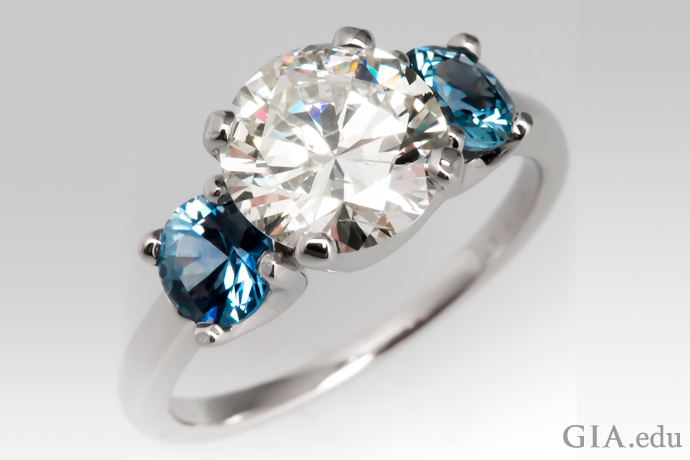
Two Montana sapphires weighing a total of 1.19 carats bookend a 2.05 ct round brilliant diamond. Courtesy: EraGem.com
Toughness and stability are two additional factors that determine a gemstone’s durability.
Toughness indicates how well a gemstone resists breaking, chipping or cracking. The way the atoms of a gem bond together and the strength of these bonds determine gemstone toughness. Examples of not-so-tough gems are opal and tanzanite which, if set in rings, are best reserved for special occasions – not everyday wear.
Stability refers to how well a gemstone can withstand exposure to chemicals, light and changes in temperature or humidity. Extreme temperature changes can damage some gems like opal and tanzanite. Opals can crack or craze in low humidity or with exposure to heat. Citrine, amethyst and topaz may fade or change color from prolonged exposure to sunlight. Light and/or heat can also negatively affect most organic gems – such as pearls, coral and amber – as will exposure to household chemicals.

Tanzanite is a beautiful gem that calls for special occasions. At 6 to 7 on the Mohs scale with fair-to-poor toughness, it’s not ideal for an engagement ring that will see a lifetime of daily wear. Courtesy: Omi Privé
It’s important to note that many colored gemstones are routinely treated to improve their color and/or clarity. Designed to bring out the inherent beauty of a gem, many of these treatments are widely accepted in the gem trade. However, you should be aware that some treatments can also affect stability. As a result, your gem may require special care.
For example, treatments such as coating and fracture filling can be removed by heat and strong chemicals. Although emerald ranks 7.5–8 on the Mohs scale, it is not a tough gem and is often treated with oil and/or resin to improve clarity. This treatment also disguises fractures in the stone that can cause it to break if banged against a hard surface. If you have your heart set on a green gemstone engagement ring you plan to wear every day, you might want to consider a more durable tsavorite garnet instead, reserving emeralds for earrings or pendants. Garnets are rarely treated and have good toughness.
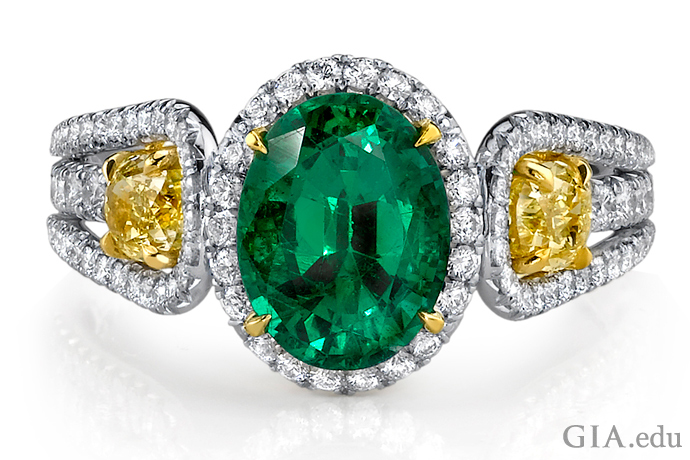
A halo of diamonds creates contrast with the emerald and helps protect this popular but fragile stone. Two yellow diamonds add more color and drama to the ring. Courtesy: Omi Privé.
Color is king
Like colorless diamonds, the quality of a colored gemstone is determined by a combination of the 4Cs: color, clarity, cut and carat weight. For colored gems, however, color is by far the most important factor. In some cases, such as whether a gem is called pink sapphire or ruby, or green beryl or emerald, the distinction may be made based on color alone. Clarity is important, but for most colored gems there is no universal grading system or set of standards to evaluate clarity. And cut may vary greatly from stone to stone. The goal is typically to maximize size and color – or, as in the case of fantasy cuts, to create a work of art.
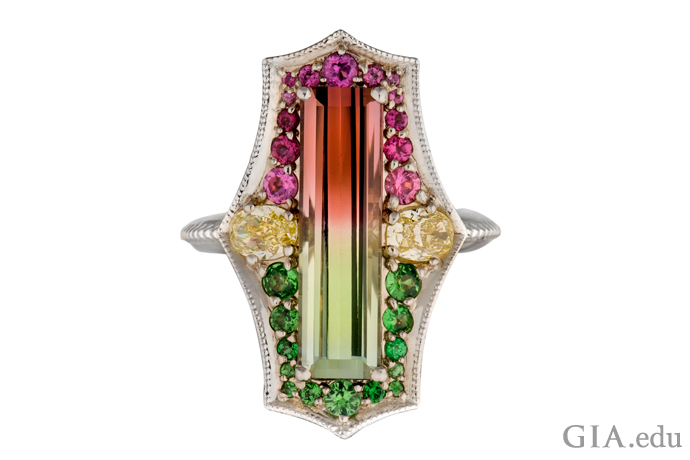
A piece of art to stand the test of time, this 9.05 ct bi-colored tourmaline ring set in 14K white gold features yellow diamonds, tsavorites and rubellites. Photo: Orasa Weldon/GIA. Gift of Derek Katzenbach. In Memory of Nicholas Scott Golden, University of Maine geology student.
There are, however, some important considerations to look for when assessing the quality of a colored gemstone in addition to the durability factors discussed above. Many gems show more than one color. This can be an asset in a bi-colored tourmaline – for the bride-to-be who wants a truly unique colored stone engagement ring.
In other gems, such as blue sapphire, colorless zones seen on close inspection may detract from the overall appearance of the gem. And while high clarity is desirable in most colored gems, as it is in diamonds, a few identifying inclusions in an inconspicuous area (such as the culet) may ensure that the colored gem is natural (not synthetic) and untreated.
Optical phenomena
Colored gemstones also offer the possibility of certain phenomena, such as chatoyancy (the cat’s-eye effect) and asterism (a star), that are not seen in diamonds. These phenomena are caused by the reflection of light off dense inclusions of minerals in gems cut as cabochons. Such phenomenal stones provide exciting design options for a colored gemstone engagement ring.

This 7.57 ct cat’s-eye chrysoberyl seems to symbolize two lives united as one. Add a sparkling halo of round brilliant cut diamonds for strength and you have the perfect sentiment for an engagement ring. Photo: Robert Weldon/GIA. Courtesy: Richard Krementz Gemstones
Where the gem comes from
For some gems, such as ruby and sapphire, country of origin may also play a significant role in determining value. For example, a ruby from Myanmar (“Burmese” ruby) can cost significantly more than a comparable ruby from another locality, such as Mozambique. Similarly, there is a premium for sapphires from Kashmir, due to both their distinctive “cornflower blue” color and their rarity: There has not been major production from this region for more than a century.
Who owned it before
Another important factor in determining price is historical provenance. An antique or vintage colored gemstone engagement ring may come with its own story, and that story may have value. In one of the most striking examples, when the Empress Josephine sapphire and diamond engagement ring mentioned above was offered at auction in 2013, the auction house estimated its value at $20,000 based largely on the gems alone. Ultimately, the winning bidder paid more than $1 million – a huge premium for the ring’s storied association with Napoleon Bonaparte and his first bride.
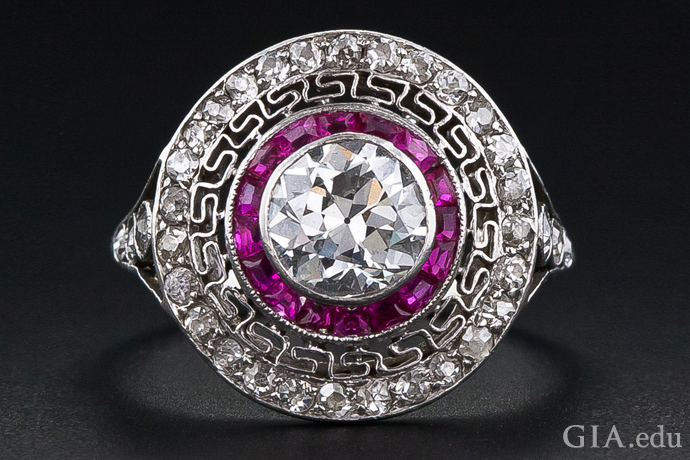
A ring of Burmese rubies encircles an Old European cut diamond in this Art Deco–era ring. A Greek key motif made of platinum circles the rubies, while another ring of diamonds completes the design. Courtesy: LangAntiques.com
Quality and rarity drive value
Like diamonds, colored gems of high quality are rare, so buyers typically pay a premium for top-quality colored stones. Once you’ve decided on a gemstone for your engagement ring, it pays to comparison shop to understand its quality factors and how they affect value. You should also learn as much as you can about your gemstone of choice. GIA’s Gem Encyclopedia is a good place to start. It provides in-depth information for 29 of the most popular gems on the market. You’ll also find detailed buying guides for each gem describing the specific qualities to look for, the gem’s durability, common treatments and more.
After you’ve purchased your colored gemstone engagement ring, you’ll want to keep it like new. The right way to clean it will vary depending on the gem material you’ve chosen and whether or not it’s been treated. Usually, gentle cleaning solutions specially formulated for delicate gems – or just warm, soapy water and a soft cloth – are all you need. If you’re uncertain about the durability of your gem, avoid using ultrasonic cleaners and off-the-shelf cleaning solutions.
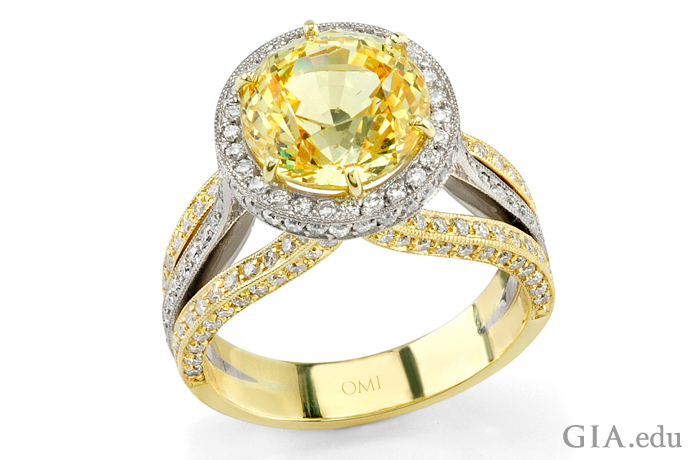
Washing with warm, soapy water is the safest way to clean this 5.11 ct yellow sapphire engagement ring, which is surrounded by 128 round diamonds weighing 0.75 carats. Courtesy: Omi Privé
Engagement ring settings must secure the gems they hold as well as show them to their best advantage. Bezels, halos and other protective settings can play an important role in preventing the chipping or cracking of colored gemstones. But who said practical can’t also be beautiful? Settings serve as an essential design element, defining an engagement ring’s style and overall look. Settings let you introduce contrasts in color or harmonize them to get just the right amount of color pop in your ring. Consider these examples:
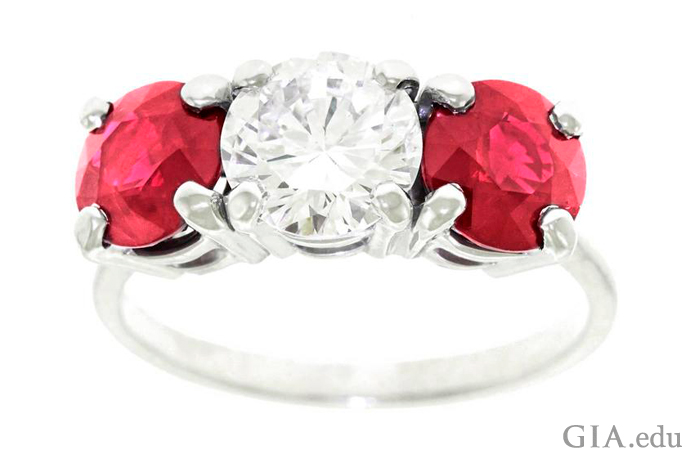
Create a fiery look in an engagement ring by using this three-stone ring for inspiration. The two rubies (1.41 ct and 1.37 ct) bracketing the 1.39 ct round brilliant diamond are sure to catch the eye. Courtesy: 1stdibs.com

Need more proof that colored gemstones can bring excitement to an engagement ring? This stunning creation features a 2.57 ct spinel encircled by 0.20 carats of round diamonds. Courtesy: Omi Privé

The diamond and sapphire in this Victorian-era bypass ring make for a delicate pairing. Courtesy: Treasurly by Dima
Jewelry designers are putting a contemporary stamp on three-stone, halo and bypass rings with colored gemstones. Their modern updates are a beautiful melding of past and present – pieces that pop with color and life. Look around and you’ll find a number of creative interpretations.

Something old. Something new. Something borrowed. Something blue. Blue sapphires surround a rose cut diamond in this modern ring with a design borrowed from the Victorian era. Courtesy: Shelly Purdy Studio
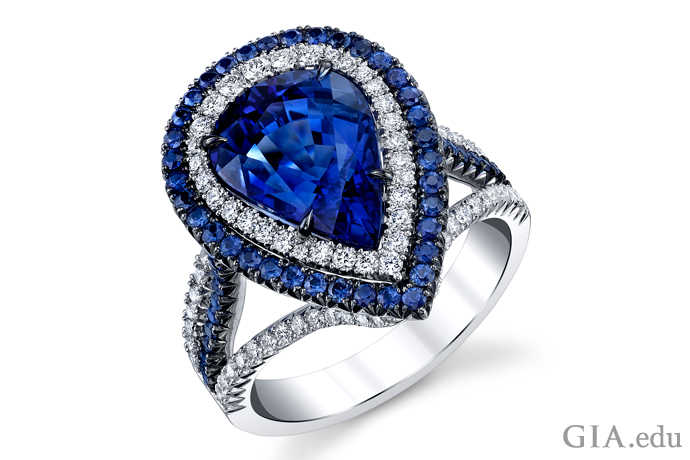
A pear shaped sapphire is surrounded by colorless diamonds and a second halo of sapphires. Diamonds and sapphires spill down the shank of the ring. The bold contrasting colors create a visual richness sure to please. Courtesy: Omi Privé
Now that you know about colored gemstone engagement rings, you’re ready to start shopping. But where? The GIA Retailer Look Up lets you easily find local retailers who have GIA-trained staff to help you through your gemstone selection process.
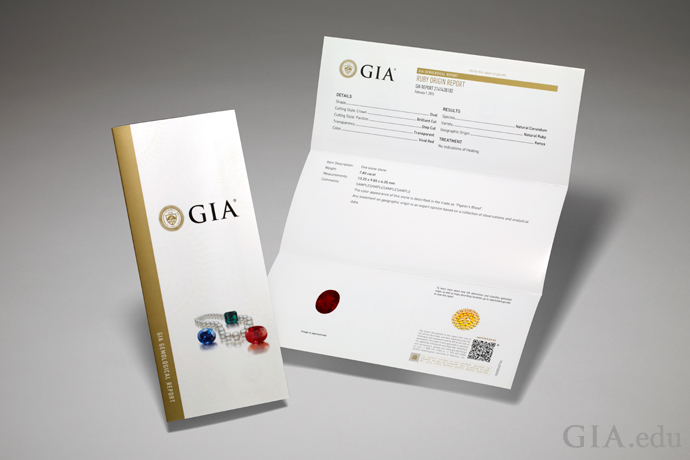
Before you decide on a colored gemstone engagement ring, ask for a GIA Colored Stone Identification Report.
To make sure you get the best value, ask for an unbiased GIA Colored Stone Identification Report. The report will validate the gem’s identity and include detailed descriptions of its size, color and measurements, along with a color photograph. The report will also indicate whether the gem has been treated and, if it has, identify the type of treatment – important to knowing how to care for your gem. Depending on the gemstone, you may also be able to get information on its geographic origin.
Need more inspiration for colorful engagement rings? Read our article on how to buy antique and vintage engagement rings for some exciting examples.
Use of this site signifies your agreement to its terms of use.
© 2002 – 2024 Gemological Institute of America Inc. GIA is a nonprofit 501(c)(3) organization.
All rights reserved.